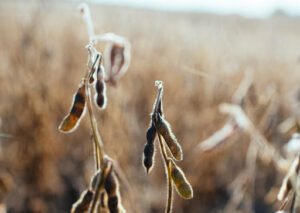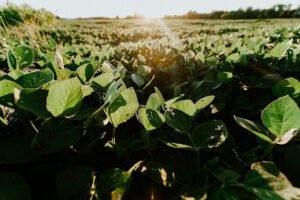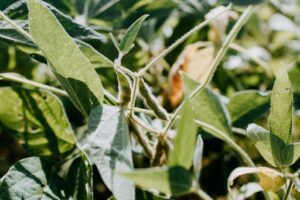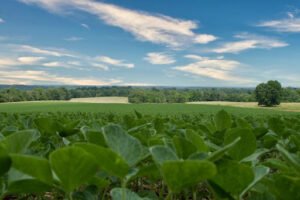Did you know that 77% of the soy produced worldwide is fed to animals for meat and dairy products? The remaining portion is used for vegetable oils, industry, or biofuels, with only 7% of soy used directly in human food products. The US’s primary protein source for humans and farm animals is soybean meal.
However, the main criticism of soy food for animal feed is that it significantly contributes to deforestation. As more people give up meat, they consume more soy, increasing demand. This article examines how much US soy is used to produce animal feed and whether it affects the ecosystem.
So, how much soy is used for animal feed?

The US is one of the largest soy producers, with a majority used to feed animals. It is also an excellent source of digestible fiber in the form of soybean hulls. US Soy is frequently used in dairy cattle diets to extend forage supplies or lower the risk of rumen acidosis.
It is a component of animal feed formulations used worldwide, especially for monogastric species. This is more due to soy’s affordability and ease of cultivation than because it makes for the best feed for livestock.
Therefore, there is no doubt that dairy cattle can receive various nutrients in their rations from soybeans and their byproducts. However, as with any feed, you must understand some restrictions to reap the full benefits of the dairy cow.
Why is soy used for animal feed?

Soy is one of the most significant crops in the world due to its high-quality protein content and other nutritional advantages. Although humans can consume soybeans, they are best known as a premium animal feed and biofuel resource. Dairy cattle are fed soybean oil meal as a source of protein. Some products made from heat-treated soybean meal add more RUP to the diet.
Farmers frequently use soy as a cheap and easily accessible protein source to supplement their livestock’s diets. Apart from providing protein to farm animals, soybeans are a good source of energy that can aid in their growth and ability to maintain a healthy weight.
There are other reasons why soy is a popular animal feed alongside corn. It is easily digestible, which means animals can easily absorb the nutrients from soy food. Also, soybeans are a more sustainable and environmentally friendly source of protein for animal feed than other sources like corn or wheat because they require less space and water to grow.
Demand for soy has changed over time

Over the past few years, soybean production for human and animal consumption has increased significantly. The emergence of new technologies and the rising demand for environmentally friendly and sustainable goods may also impact soy demand.
Soybean production has skyrocketed worldwide within the last 50 years. For example, today, global production of soy is about 13 times higher than 70 years ago. While the US only produced 20 to 30 metric tons of soy annually in the 1960s, it now amounts to 350 million tons. This soy has grown significantly due to the rising demand for vegetable oils, biofuels, and animal feed,,
This soy production has doubled since 2000 as animal feed, primarily for pigs and poultry. The expansion of croplands has been a major factor in the production increase. Although impressive, this is insufficient to meet demand. As a result, countries must allocate more land for soy production to meet the growing demand. Soy production has not been able to match crop yields.
For example, while global yields have increased by 150% since 1961, production rose by 1200%. This indicates a more than quadrupling of the area used for soy farming.
What are the risks of increased soy production?

Increased soy production on land carries several risks, including the potential for deforestation. Soybean production can harm the environment since soybeans require more land to produce food that meets the growing demand. As countries devote more land to soy production, it comes at the expense of forests. Deforestation is a risk associated with increased soybean farming, especially in areas where large tracts of land are cleared to make way for new soybean fields.
Cutting down forests for soy production can negatively affect the environment. Hence, growing soy to feed tens of billions of farm animals harms the environment because an excessive and unsustainable amount of beans must also be grown.
Increased soy production also risks contributing to soil erosion and degradation. Large monoculture fields are used to grow soybeans, which can cause nutrient depletion and reduce the soil’s ability to support other crops. This may lower the land’s general productivity and make it more challenging for farmers to grow various crops in the future.
Increased soy production can also lead to increased use of pesticides and fertilizers, negatively impacting the environment and human health. Pesticides and fertilizers used on soybean crops can also harm nearby wildlife and contaminate water supplies.

The environmental impact of soy-fed livestock food is significantly greater than that of soy food without livestock. The main reason for its continued growth is rising meat consumption. A solution to prevent over-farming can be consuming soy as a form of vegan food instead of first cycling it through animals. Consuming soy directly instead of through animals would result in less natural vegetation being cleared.
Bottom line
Including soybeans and their byproducts in the rations for dairy cattle is typical. It is a highly efficient protein source for animals and an excellent source of essential amino acids. Soy also fits into any forage-based ratio. Depending on how they have been processed, they can provide high-quality, degradable, undegradable, and soluble protein, energy, fat, and fiber.

